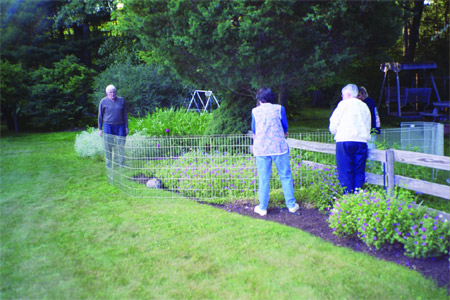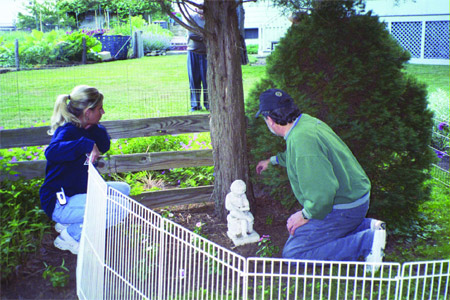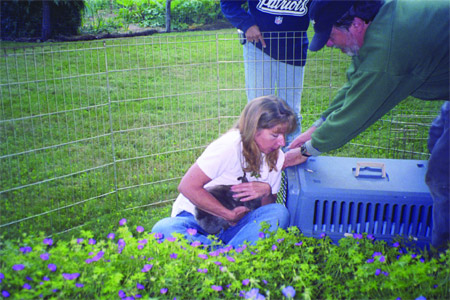Rescuing Rascally Rabbits
by Carol Youngclaus

This is during a stray capture – about 5 exercise pens were used to completely surround the rabbit, a tree, a fence and lots of garden area.
|
This article is dedicated to Zorro, a beautiful black bunny who left an indelible impression on my right forearm. He’s safe in foster care now, and I hope he finds his forever home very soon – he’s such a sweetie! Whoever said rabbits are dumb got it wrong. Way wrong! Anyone who has ever tried to capture a stray bunny will tell you that. But an abandoned or runaway bunny’s chance of survival depends on successful human intervention. Depending on location and time of year, a stray domestic bunny faces attack by dogs, cats, raccoons, birds of prey, coyotes, even mites and maggots. And, unfortunately, you can’t reason with a rabbit – s/he will think you’re just another very large creature looking for a meal. Chasing a rabbit is futile. Rabbits run very fast in unpredictable, constantly changing directions, and they can squeeze into seemingly impossible, impenetrable places. Even the rare uber-friendly bunny who will let you get close enough to touch will bolt if you try to pick him or her up, and then you’ll have a spooked bunny who will be even harder to catch the next time. So since you can’t outrun a rabbit, you have to outwit it. And that’s where a little experience helps a lot. The stray rabbit is under a small pine tree here, but is completely surrounded by exercise pens, so there is a slim chance of her escaping capture by volunteers. You might be tempted to try a Havahart® trap. This can sometimes be successful, but more often than not it results in a captured skunk or raccoon while the rabbit stands at the edge of the garden laughing at you. If you want to give it a try (or need to, if you’re trying a single-handed rescue), be sure to set the trap up in the early morning and/or evening and be prepared to monitor it closely. Do not set the trap and walk away expecting a live rabbit to be waiting for you in a few hours! Even assuming the trap works and the rabbit is captured, the poor bun will be terrified and at the mercy of any other animal that comes by. You may think the bun is safe inside the trap because other animals can’t get at it, but rabbits have a tragic mental coping mechanism: when a predator comes close enough to terrify them, they can simply go into shock and die. (In fact, this is one of the strongest arguments against keeping rabbits in outdoor hutches or letting them play outside.) So now that you know what not to do, here are some techniques that usually do work: Have a plan. Know what to do for the rabbit once you capture it. Make sure you have a pet carrier or a very sturdy ventilated box readily at hand. Have fresh hay or greens (romaine lettuce, carrot tops, parsley, kale or dandelion greens are good choices – avoid iceberg lettuce or anything from the cabbage family) along with fresh water in case the bun wants any of these things, but don’t be surprised if s/he is too scared to take them. Get as many volunteers as possible to help you, and then coach them ahead of time on the right and wrong techniques. Enlisting a posse can be the difference between success and frustration. Plan your rescue on “rabbit time”. Since rabbits are most apt to emerge at dawn and dusk to feed, your best chance for success will be in the early morning and late afternoon/early evening. Think like a rabbit. Try to determine its habits. Pay attention to where s/he comes and goes. Look for fresh droppings, chewed plants or gnawed bark, spots where the ground has been dug a little (domestic rabbits rarely dig deeply enough to burrow deep into the ground, but they often do start holes and depressions, especially in soft ground near the edges of open areas). If you see a small hole, check to see if it might be a rabbit escape route (see Joey’s story). Do some pre-work long before the rabbit tends to emerge and feed. Try to block off escape routes, leaving only one or two ways out. The most effective way to do this is to use ex-pens, which are folding metal or plastic grates that can be linked together to form a corral. If ex-pens aren’t available or you have only a limited number, almost anything will do as long as it is high enough to prevent an escape leap (note: some rabbits are great jumpers, so three feet tall is apt to be inadequate!), sturdy enough to stop a barge-through/under, and safe enough to prevent injury to the humans and rabbit (no barbed wire, sharp edges or exposed nails). Prepare to wait. And wait. And wait. Practice stillness. Practice silence. Make yourself invisible. Wait some more. At this point, the rabbit has the advantage and any hasty move on your part will most likely doom the effort to failure. When the rabbit finally does turn up, wait some more. Make sure you can close all escape routes before s/he can get to them. When the time is right, have all volunteers close off the open ends and reinforce any areas along the perimeter that might be breached. Then gradually bring the edges in toward the rabbit until s/he has no room to run. Only then should the most experienced, confident rabbit handler step into the enclosure and pick up the rabbit, holding it against his or her chest, with one hand securing the bunny’s butt and the other hand securing its shoulders. Note: Don’t be timid! Be willing to be kicked, scratched and bitten without letting go or allowing the rabbit to kick hard enough to break its back! Try to hold firmly and try not to injure the rabbit. This is obviously a judgment call: If the potential injury would likely be grave, just let the bunny go; you can try again later that day or the next. At the other extreme, if the rabbit is in immediate peril (e.g., from known predators, lack of safe cover, extreme weather or the rabbit’s own poor physical condition), try hard to capture him or her. You’ll need to find the fine line between excessive force and firm determination. Remember that while you must try not to hurt the rabbit, he or she will be given veterinary care right away, and there are therapies for unavoidable small problems.
The stray rabbit was caught within the confines of the ex-pens by and HRN volunteer. This particular capture took almost two days of waiting and many volunteers. What if you know where the rabbit hides but you can’t reach him or her? There’s a plan for that, too: If the enclosure is small, such as under a shed, block off all but one side against the building. At the open end, widen your enclosure so that the bunny will have some run room (at least 8–10 feet if possible) once s/he emerges. Then use a long stick such as a flagpole to “persuade” the bunny to leave the hideout. Once the rabbit is in the open, wait until you can reach the hole and close it off before the bun can get back to it. If you pounce too soon, your opportunity will be lost. If the enclosure is large, such as under a garage or the crawl space of a house, you’ll have to wait (sometimes for a very long time) for the bun to emerge on his or her own. After that, the procedure is the same – make sure you can reach the escape hole before the bunny can. In both cases, and depending on the actual territory, you might want to give the bunny a lot of run room within your enclosure. This will ensure that the bunny won’t have time to go back underneath the building. Then, as with an open capture, slowly bring the edges of the barrier together until the rabbit has nowhere to go and then send in your most confident, experienced wrangler to pick him or her up. What to wear and what to bring: 1. Make sure you’re dressed for insects in summer (check for ticks afterwards, too!), for cold in winter and in waterproof rain gear in inclement weather. You’ll be standing stock-still for long periods, so cold will feel much colder and wet will feel much wetter! One trick that works particularly well in cold weather is to wear a portable thermal pad inside your coat and hand and foot warmers inside your gloves and shoes; hats, of course, are essential. 2. You’ll need to bring flashlights. Even in daylight, there will be dim bunny hideouts, and many bunnies stay out until well after dark. 3. A long stick or flagpole can be very helpful for “persuading” a bunny to leave its hideout under a building, bush or shed. 4. A treat such as a small piece of banana might tempt a reluctant bunny to emerge from its hiding place. It can’t hurt to stick one in your pocket. 5. Communicate with your posse via cell phone, not voice or unsubtle hand signals – there’s nothing like an excited shout to spook a rabbit! Make sure team members have each other’s phone numbers. 6. Don’t forget to bring a carrier for each bunny you’re trying to capture. Don’t expect this to be quick or easy, and don’t give up too soon. Most rescues take at least two hours, not counting travel time. It isn’t quick or easy to catch a runaway rabbit, but the satisfaction of saving that little life is indescribable! by Carol Youngclaus |


